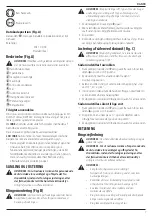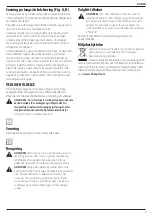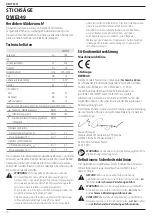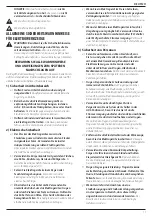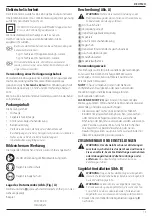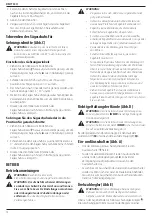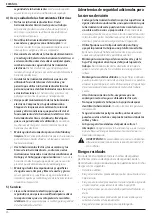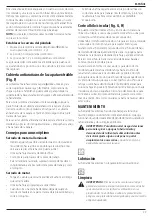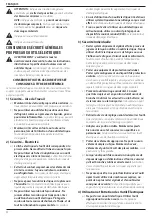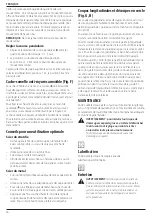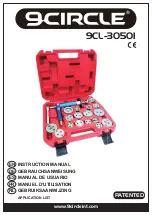
21
EngLIsh
Cutting Action – Orbital or Straight (Fig. A)
WARNING:
Check that the tool is not locked ON before
connecting it to a power supply. If the trigger switch is
locked on when the tool is connected to the power supply,
it will start immediately. Damage to your tool or personal
injury may result.
Variable Speed Control (Fig. E)
WARNING:
If the tool is operated continuously at low
speeds for a long time, the motor will get overload and
heated up.
A speed control dial
8
is located on the top of the saw. The
speed increases as the dial is turned from a low speed setting of
1 to a high speed setting of 6.
Refer to the table to select the proper speed for the workpiece
to be cut. However, the appropriate speed may differ with the
type or thickness of the workpiece. In general, higher speeds
will allow you to cut workpieces faster but the service life of the
blade will be reduced.
Material
Variable Speed Control Setting
Wood
5‑6
Stainless steel
3‑4
Mild steel
3‑6
Aluminum
3‑6
Plastics
1‑4
Switching On and Off (Fig. A)
• To switch the tool on, squeeze the trigger switch
1
.
• For continuous operation, squeeze the trigger switch then
depress the lock‑on button
2
. Once lock‑on button is
depressed, release the trigger switch.
• To switch the tool off, release the trigger switch. To switch
the tool off, when in continuous operation, squeeze the
trigger and the lock will disengage.
Proper Hand Position (Fig. D)
WARNING:
To reduce the risk of serious personal injury,
ALWAYS
use proper hand position as shown.
WARNING:
To reduce the risk of serious personal
injury,
ALWAYS
hold securely in anticipation of a
sudden reaction.
Proper hand position requires one hand on the front handle
13
,
with the other hand on the main handle
12
.
WARNING:
• Make sure your workpiece is well secured. Remove
nails, screws and other fasteners that may damage
the blade.
• Check that there is sufficient space for the blade
underneath the workpiece.
• Do not cut materials that exceed the maximum
cutting depth of the blade.
• Use sharp saw blades only. Damaged or bent saw
blades must be removed immediately.
• Do not use the tool for sawing pipes or tubes.
• Never run your tool without a saw blade.
OPERATION
Instructions for Use
WARNING:
Always observe the safety instructions and
applicable regulations.
WARNING:
To reduce the risk of serious personal
injury, turn tool off and disconnect tool from power
source before making any adjustments or removing/
installing attachments or accessories.
An accidental
start-up can cause injury.
Adjusting the Shoe for Bevel Cuts (Fig. C)
WARNING:
Never use the tool when the shoe is loose or
removed. The shoe plate can be set to a left or right bevel
angle of up to 45 °.
To Set the Bevel Angle
1. Pull the shoe beveling lever
7
out and away from the saw
to unlock the shoe
6
as shown in Figure C.
2. Slide the shoe forward to release it from the 0 ° positive
stop position.
3. The shoe can be beveled to the left or to the right and has
detents at 15 °, 30 ° and 45 °.
4. Set the shoe to the desired bevel angle. Use a protractor to
verify angle accuracy.
5. Push the shoe beveling lever back towards the saw to lock
the shoe.
To Reset the Shoe for Straight Cuts
1. Pull the shoe beveling lever
7
out and away from the saw
to unlock the shoe
6
as shown in Figure C.
2. Rotate shoe to an angle of approximately 0 ° and then pull
shoe backwards to engage the 0 ° positive stop.
3. Push the shoe beveling lever back towards the saw to lock
the shoe.
1. Push the saw blade locking lever
3
upward.
2. With teeth facing forward, insert the shank of the saw blade
into the blade holder as far as it will go.
3. Release the lever.
4. Check to ensure blade is secure before cutting. A loose saw
blade can fall out an lead to injury.
• For optimal results, move the tool smoothly and
constantly over the workpiece. Do not exert lateral
pressure on the saw blade. Keep the shoe flat on the
workpiece and lead the cord away in line with the tool.
When sawing curves, circles or other round shapes,
push the tool gently forward.
• Wait until the tool has come to a standstill before
removing the saw blade from the workpiece. After
sawing the blade may be very hot. Do not touch.
Summary of Contents for DWE349
Page 1: ...DWE349 ...
Page 3: ...1 Fig A Fig B Fig C 4 3 10 9 1 2 8 7 5 6 3 6 7 11 xx xx xxxx ...
Page 4: ...2 Fig D Fig F Fig E 8 13 12 9 6 5 ...
Page 5: ...3 Fig G Fig H ...

